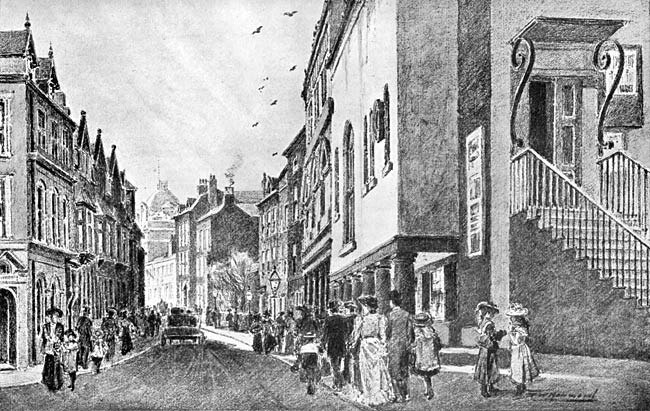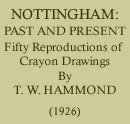< Previous | Contents | Next >
NOTTINGHAM PAST & PRESENTSTREETS AND YARDS
HIGH PAVEMENT, 1895

This picture—which is drawn from Weekday Cross—shows us the bustle in High Pavement about service time at St. Mary's Church on a fine Sunday; but in addition to its artistic interest it brings to our mind many of the historical associations of the neighbourhood.
In the first place, Weekday Cross itself is of interest. The open space which we know is all that remains of the Market Place of mediaeval Nottingham, and it speaks of far off Saxon days when this was the market place of the old Borough. After the Conquest, William Peverel established the present Great Market Place, and in it was held the Saturday market, to which country people from the surrounding district brought their produce. The daily market, however, remained at Weekday Cross and there townsfolk exposed their wares and transacted their business under the shadow of a great Market Cross, which was one of many crosses in Nottingham : from the foot of this one, Royal proclamations were made. Near by was a set of stocks, and the records of 1580 refer to a bull-ring, while the pillar box at the corner of Middle Pavement and Fletcher Gate marks the site of the ancient Market Well.
In High Pavement—on the left side of the drawing—exactly opposite to Garner's Hill, stood the old Blue Coat School from 1727 to 1853 when it was removed to its present position in Mansfield Road. The School was established in 1706, but its original site is unknown.
In the distance may be seen the County Hall, which is one of the most extraordinary buildings in Nottingham, if not in England. Although situated in the heart of the city, part of it does not belong to the city at all, but is legally classified as being in the county, and the residents in it record their votes at Wilford. Its history is too long to enter into here, but the boundary lines of the original building lead to most amusing vagaries in the county and city boundaries—for example : the boundary line runs right across the criminal court, so that while the judge is sitting in the city the prisoner at the bar stands in the county.
The trees on the right hand side of the picture indicate the position of the High Pavement Unitarian Church. This was founded by three ejected clergymen—J. Barratt, John Whitlock and William Reynolds. The Test Act of 1662 made it impossible for these gentlemen to remain in their livings of St. Mary's and St. Peter's, and they suffered considerable persecution until the Act of Toleration in 1686, when they were enabled openly to renew their ministry and founded a chapel upon the site now occupied by the High Pavement Unitarian Church.
The extreme right of the drawing is taken up by the old Guildhall. This was originally the Moot Hall of the English Borough. After the Conquest—owing to the constant quarrels between the English, who were the original inhabitants of Nottingham, and the French followers of William Peverel who was established at the Castle—it became necessary to divide the town into two portions, each with separate officers; and this Moot Hall for the English Borough was conveniently situated for the English market at Weekday Cross. How long before the Conquest a Moot Hall had been established here is unknown, but probably it had existed for many centuries. It recalled many historical events; perhaps one of the most pathetic is its association with George Fox, the founder of the Quakers, for within its walls in the year 1649—following upon his interruption of the service in St. Mary's Church—he suffered one of his earliest imprisonments. Fox refers to it in his diary as 'a nasty, stinking prison; the smell whereof got so into my nose and throat that it very much annoyed me'.
The building was pulled down to make way for the Great Central Railway at the close of the nineteenth century.
